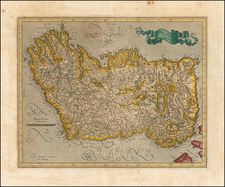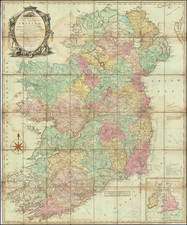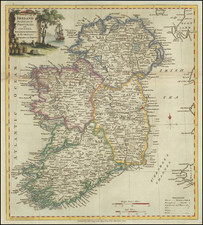John Tallis's 1851 hand-colored town plan of Dublin represents one of the era's most detailed and aesthetically appealing urban maps. As one of the few double-page plans published by Tallis, the piece offers a comprehensive view of the city, enriched by a series of skillfully rendered vignettes.
The capital and largest city of Ireland, Dublin, boasts a rich history that spans more than a millennium. During the mid-19th century, the city was undergoing rapid industrial growth and development, and Tallis's map captures this dynamic period with the precision and vibrancy that were his trademarks. The map offers more than a mere representation of Dublin's streets and landmarks—it offers a visual narrative of a city in the throes of change and growth.
The map includes artistic renditions of significant Dublin landmarks such as the Customs House, South Wall Lighthouse, Nelson's Column on Sackville Street, Four Courts, and St. Patrick's Cathedral. These vignettes lend the map an additional layer of visual and historical depth, grounding it firmly within its historical context.
Engraved for R. Montgomery Martin's Illustrated Atlas, this town plan stands out as a testament to Tallis's distinctive style. As one of the last prominent figures in the world of decorative map making, Tallis's works are celebrated for their intricate detailing and engaging depictions of local scenes and figures. This map, with its artful blending of urban geography and artistic rendition, embodies the distinctive characteristics that make Tallis's works sought-after items in the world of historical cartography.
John Tallis (1817-1876) was a British map publisher. Born in the Midlands, Tallis came to London in the 1840s. Tallis began his London career with a series of remarkable London street views. He began a partnership with a Frederick Tallis, possibly his brother, but their collaboration ended in 1849. For the Great Exhibition of 1851, Tallis published the Illustrated World Atlas, one of the last series of decorative world maps ever produced. The maps were engraved by John Rapkin, a skilled artisan. The maps were later reissued by the London Printing & Publishing Company, who left the Tallis imprint intact, thus ensuring his enduring fame. In 1858, he began publication of the popular Illustrated News of the World and National Portrait Gallery of Eminent Personages, selling it in 1861 (it ceased publication in 1863).










![(Guinness Monopoly) James's Gate Brewery [The Bung Frankenstein, or the Collar of Gold]](https://storage.googleapis.com/raremaps/img/small/94984.jpg)

![Johnson's Ireland [with] Johnson's Scotland](https://storage.googleapis.com/raremaps/img/small/78184.jpg)
![(British Isles) Tabu Moder Anglie & Hiber [Modern Map of England and Ireland]](https://storage.googleapis.com/raremaps/img/small/103164.jpg)
